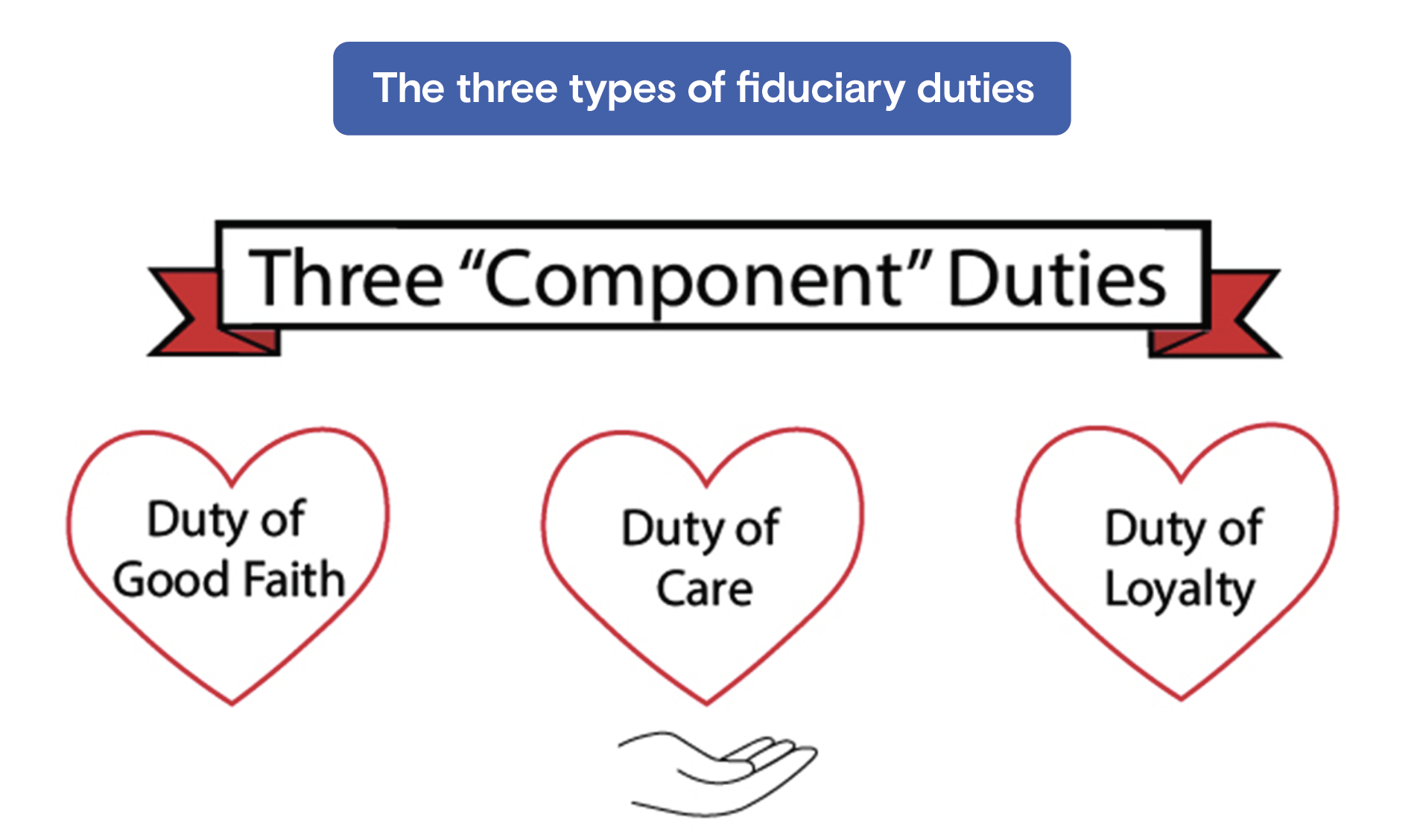The fundamental duties of the board
Nowadays, there are a growing number of rules and regulations to follow, depending on the type of board. The board of directors is required to keep up with increasingly stricter responsibilities, expectations, and risks.
Boards exist to offer strategic oversight for a company, as well as to protect shareholders’ financial interests. Therefore, those who wish to serve on a board must be willing to take the responsibilities associated with being a director, whose primary duty is to help the board accomplish its goals.
As an initial guide, BoardPro has put together the eight basic functions of a board.
Contents
Strategic Navigation
Hiring a CEO
Evaluating the CEO's performance
Policy
Financial Oversight
Self Evaluation
Risk Management
Fiduciary Duties
Strategic Navigation
What does strategic guidance mean for the boardroom today? As their arguably most important task, the board of directors must be prepared to envision the company’s future and find the best ways to guide the company to accomplish that vision. To fully understand what strategic guidance means precisely, let’s break down the two words individually and take a closer look at what they mean.

 Strategy
Strategy
Setting the company’s plan of action is an essential responsibility for the board of directors. It must contribute its composite of individual knowledge and experience to establish the best path forward for the business.
Strategic thinking consists of many elements, such as goal setting, prioritisation and realistic financial planning, to name a few. Therefore, board members are expected to look at the horizon rather than simply at the ground beneath their feet.
 Guidance
Guidance
It can be difficult to balance being overly distant and too overpowering, but board members must find the perfect middle ground between the two to provide clear and impactful insight as they work together. Board members must work together to see positive growth, so even if there was a brilliant, innovative strategy, it would remain futile if it is not delivered through practical guidance. Throughout all their responsibilities, board members must review their strategic values and guide the company through the decision-making and implementation processes.
Hiring a CEO
 Aside from strategy setting, another important responsibility for any board is to oversee the CEO selection and succession planning processes. A CEO’s legacy can be felt for years after their departure, whether it is a positive or negative influence; therefore, selecting the right person for the job is crucial for the company. The corporate landscape is ever-changing, where CEOs will inevitably alternate and vary; so, boards need to create a reliable process for selecting a CEO that is best suited to their organisation.
Aside from strategy setting, another important responsibility for any board is to oversee the CEO selection and succession planning processes. A CEO’s legacy can be felt for years after their departure, whether it is a positive or negative influence; therefore, selecting the right person for the job is crucial for the company. The corporate landscape is ever-changing, where CEOs will inevitably alternate and vary; so, boards need to create a reliable process for selecting a CEO that is best suited to their organisation.
It may be wise to involve the exiting CEO in the new hiring process if they are merely retiring or moving on to another opportunity on good terms. No one will comprehend the duties of the position better than someone who has just experienced them. However, if the board does not have a solid belief in the departing CEO, the lead director should take charge of the hiring process instead.
Scouting for suitable candidates begins with a realistic look at where the company is currently, and where the board envisions its future. Then, the board should look for a CEO candidate who will complement their vision for the future and is capable of tackling the challenges of the board. For example, if the company is a non-profit organisation, it would be wise to look for candidates who have had previous experience in the non-profit area, so as to be sure that they know the rules and regulations involved.
Sometimes, the board might need the aid of outside consultants or executive search advisors. Regardless, members of the board should all be aware of the process of hiring. Once appropriate candidates have been identified, the board should follow its internal procedures for evaluating how well the candidates meet the company’s culture, as cultural fit is crucial to the long-term success of any organisation.
Once the right successor is identified for the CEO job, the board must also propose a suitable salary. As the board determines the salary, it is important to ensure that it is not overspending on certain directors, causing a potential detriment to the shareholders.
The CEO is known to be the leader of the company with the ability to lead the other members and set the tone of the organisation. This is why the board members must contribute their relevant knowledge and expertise when finding the right leader and as well as establishing a realistic succession plan for the future.
Evaluating the CEO's performance
1. Follow a CEO scorecard system
Joel Trammell at Forbes encourages board members to ‘grade’ various aspects of the CEO’s performance. He proposes that multiple categories, such as vision, culture and decision-making, should be evaluated, so that meeting financial goals is not the sole indication of a successful CEO.
If the CEO is achieving well in most or all of the categories, then the CEO is suitable for the organisation at large, particularly for the shareholders. It is also important to have the CEO complete a self-evaluation on these categories to gain personal insight from the person who is at the very centre of the company.
2. Meet with those who work closely with the CEO
Sometimes, board members will make extra effort and reach out to other executives who work closely with the CEO. This could involve conducting interviews with them or asking them to fill out anonymous surveys to gain a more comprehensive understanding of the CEO’s performance. This style of evaluation lets colleagues evaluate the CEO at various levels - those who work below the CEO, those who work alongside them and those who serve as board members. This can help leaders recognise and address their blind spots from all angles.
Policy
While policy making may not be the most attractive side of board membership, it is certainly essential. Company policies impact every aspect of governance and decision-making. Expectations for board members are soaring; therefore, policy making has become a key way to reduce liabilities.
So what exactly is a corporate policy, and why does it exist? As opposed to processes and procedures, policies are overarching protocols for the company. BusinessDictionary.com defines policy as “a documented set of broad guidelines, formulated after an analysis of all internal and external factors that can affect an organisation’s objectives, operations and plans.” In other words, policies exist for the same reason the board does – to guide the company into the future strategically and effectively.
Experienced CEO and governance consultant Steven Bowman says that boards should create a strong policy focus. He writes, “Clear, concise and current policies improve the overall management of the organisation… By having these documented, …[the board] speaks with one voice – avoiding a problem that many organisations have with multiple sources of policy guidance.” Unfortunately, many boards fail to maintain a policy focus. Bowman goes on to say: “When I was still a chief executive officer, I led an effort to get my board to establish and document the policies that were needed to govern the organisation… When I talked to the board about creating a policy focus, there was some confusion about what policies are and what they are not.”
1. Good policies change over time
While crafting a successful policy is important, it is just the first step. The best policies are ones that are vetted and re-evaluated year after year. Boards need to pay attention to the changing corporate landscape, so they can understand how their policies can remain most applicable within that landscape.
2. Concentrate on excellent governance
Some of the best policies are ones that make the board stronger in general. In fact, board members should view policy making as a way to improve their own governance system because well-written policies guide them towards a clear decision-making, thereby streamlining all of the processes involved.
3. Work closely with the CEO
Although it is the board of directors’ job to create policies, as the highest-ranking policy-making body within an organisation, it doesn’t mean that they should act alone. It would benefit the company to regularly consult with the CEO and other executive leaders to comprehend the everyday experience of working within a company. Note that some of the most exciting and relevant policies come from leaders on the inside.
Financial oversight
Financial oversight calls for a board’s attention to detail and ability to understand the current position of the company’s financial assets. And while every decision a board member makes may not be a financial one, all of their decisions will affect the financial future of the organisation they serve.
Therefore, providing the company with great financial oversight takes serious effort from board members. Below are three ways board members can offer financial oversight.
1. Be aware of financial reports and interrogate
This may seem intuitive, but it is relevant advice for any board member. As boards often contain budgeting and auditing committees, other members sometimes lose sight of financial oversight. Every board member needs to have a firm understanding of the company’s latest financial position, even if it’s not in their particular area of expertise. And if the financials look suspicious or confusing, don’t assume someone else will speak up or will better understand. Ask management for a satisfactory explanation!
2. Take advantage of good policies
Having good policies in place can provide excellent financial protection for a company. Here are some examples of policies that can make a big difference:
- An interest register (conflict-of-interest) policy to protect against self-dealing transactions
- A document retention policy to guard against loss or destruction of documents
- A code of ethics to establish conduct guidelines for the board, management and staff
- A whistle-blower policy that protects staff who report unethical or unlawful practices within an organisation
3. Offer in-depth training
Sometimes, even board members who are selected to handle most of the financial oversight are not always thoroughly versed in the field. In such cases, bringing in an outside expert to provide the entire board with comprehensive training could be a great way to improve understanding of the company’s financial situation.
Self-evaluation
Yearly self-evaluations provide a great resource for improving board functionality. Willingness to self-assess sets the tone for the organisation at large; it shows that board members take their roles — whether it's as chair, treasurer or other role — seriously by reviewing their own performance through a critical lens.
Board self-evaluations can help identify group strengths and weaknesses. Discussing board members’ responsibilities and goals can also create a more unified and collaborative working environment. And finally, tracking year-on-year changes in board members’ responses can provide meaningful insight into a changing board landscape.
What happens after?
Unfortunately, many boards stop at asking their board members to conduct self-evaluations. But proper, effective board self-regulation means taking what you’ve learnt from those evaluations and putting it to good use. For instance, in the survey process, board members might discover that they collectively feel as though meetings are ineffectively running too long. In that case, they can review their options for strengthening meeting processes and make appropriate changes.
Boards are ever-evolving. And as board members don’t have anyone watching over their shoulders, it is important that they take on that responsibility for themselves. Otherwise, how will they know how to improve?
Risk management

1. Set the tone
Board members should set the tone for company leadership by placing risk management near the forefront of their governance priorities. In addition, the CEO should be made aware that the board expects sensible risk mitigation to be integrated into all business decision-making.
2. Don't avoid risks
Being good at risk management doesn’t mean avoiding risk altogether. A huge part of any risk oversight plan is gauging a company’s risk appetite, which is the amount of risk an organisation can accept while pursuing strategic objectives. Risk is not always bad; in fact, it can be a robust process that helps management and the board understand exposures and make appropriate risk-based strategic decisions.
3. Take the stress test
The hypothetical risk stress test helps a company assess and analyse how the organisation would be affected by an assortment of small to large catastrophic events, be it a shift in regulations or a major natural disaster. This stress test gives board members some training in what it would be like to respond quickly to an unforeseen challenge. But more importantly, it gives them a way to identify the holes in their current risk management policies.
Fiduciary duties
The foundation of a board member’s service is their fiduciary duty to shareholders. But before look at the duties involved, what does fiduciary mean?
It’s a word that we hear a great deal in the corporate world, but its basic meaning is often overlooked. Simply put, ‘fiduciary’ is all about trust, and that is exactly what is required of board members under corporate governance law.

1. The duty of good faith
This duty requires that after board members have explored all the options for a particular business decision, they must make the one that they believe best serves the interests of shareholders. According to Cornell Law School, “a violation of the duty of good faith may include an intentional derelict in the usual duties of a director or officer, intentionally acting for a purpose other than the benefit of the corporation, or intentionally violating the law.”
2. The duty of care
The duty of care is an ethical and legal fiduciary responsibility held by the board of directors that requires them to live up to a certain standard of care. It requires them to make decisions in good faith and in a reasonably prudent manner. The board members are required to be sensible and knowledgeable in making business decisions to fulfil their fiduciary duty.
Board members meet their duty of care by acting:
- In good faith
- With the care of a reasonable person in a similar position
- With reasonable belief, their decisions are in the best interests of the organisation
3. The duty of loyalty
Duty of loyalty is all about making sure that board members never allow outside interests or personal affiliations, or allegiances to intervene with their responsibility to shareholders. This means that board members should not involve their personal interests in professional dealings or put their self-interest or that of another person or business above the interests of the company.
Board members meet their duty of care by not:
- Gaining secret profit that belongs to the organisation
- Competing with the organisation
- Seizing corporate opportunity
- Self-dealing with the organisation
If you're looking for a tool to streamline your Board processes, check out BoardPro - an all-in-one software solution designed specifically for Boards and busy CEOs!
Schedule a demo with our team today and begin to experience a whole new way of meeting.
Share this
You May Also Like
These Related Stories

What type of director are you?

The relationship between the CEO and the board of directors




